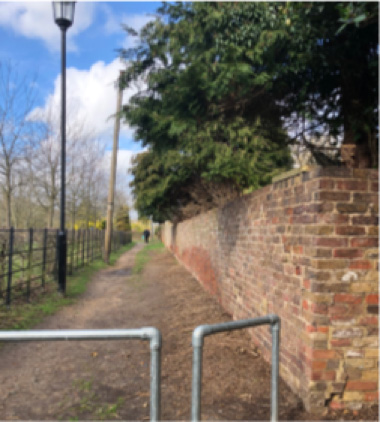Orchard Meadow is the centre of village life in Lower Sunbury. On foggy winter mornings, it is home to a handful of geese and a group of exercise enthusiasts. In spring, children start to animate the wooden playground on its edge.
As the weather warms, families have picnics and impromptu football games, while schools stage sports days. As summer arrives, the meadow comes into its own, with high grass rising all around the field. Wildflowers speckle the tall grass. It’s an archetypal English scene that draws people from far and wide.
Key to the appeal of Orchard Meadow are its surroundings. On one side, a path leads to the wrought iron gates of the Walled Garden, with its beautifully tended parterres and range of extravagant trees, mingling palms and magnolias.
Another path leads through a smaller gate into Sunbury Park – where cattle roam in the summer. Above the trees the distinctive spire of St Mary’s Church can be seen – with its bells ringing out on Sunday morning or for weddings and funerals. On another side of the meadow lies Thames Street with its range of unspoilt historic houses – Georgian, Victorian and Edwardian. Their beauty is heightened by the knowledge that the backs of these houses face the Thames.
The river flows past Sunbury Lock and its island against which a flotilla of boats cluster. And on a final side of the meadow, there is a row of tall Victorian houses, set back a little from a small path that leads along a very old brick wall.
All these surroundings frame Orchard Meadow perfectly and make it one of the most beautiful spots in Spelthorne – a miracle so close to London. But although this is a place and a view that gives off a sense of permanence and harmony, it was only achieved through hard work and persistence. It is now a conservation area, but go back a decade or two and it could all have been quite different. The meadow had been allowed to become a wasteland and property developers were poised to pounce.
If their plans had gone through, there would have been no meadow but a housing development. The Walled Garden was also salvaged and restored. Local residents and the council united in a vision to recreate an idyll in the middle of Lower Sunbury that matches its magical setting on the Thames. The project was not against development in Lower Sunbury – there have been many bringing new life in recent years. But it gave the village a heart and soul that so few places have been able to keep.
Now there is a new threat to that vision – although on a smaller scale. A property developer has proposed plans for three new houses on one side that frames Orchard Meadow. The application by the developer and his architect argues that it will be an asset, bringing new life to the area while enhancing its look. The application disparages the current arrangement, seeing little harmony in the view across the meadow.
It suggests that this will be improved by having three small modern boxes running along one side of the green. The brick wall along the ancient old rope walk pathway will go, the view through a jumble of trees to the high windowed Victorian town houses will be lost – as will the symmetry with the row of historic houses along the Thames.
Just before the Magpie pub, they rise high to twin ornate Victorian river houses built for themselves by the brothers who built the row of terraces – which were locally listed in 2004 – facing them across the meadow from the Avenue.
Just as the meadow itself and the walled garden were saved from destruction and then renewed and reborn, so should their surroundings be preserved from unnecessary and inappropriate development. The developer and his architect say they are building on wasteland. But this is not true – until the developer bought the property, it was a well tended garden that reflected the natural beauty of its surroundings.
By cutting it off from the house and building a fence, it has intentionally been made a wasteland. But it remains a garden – containing an extraordinary, gnarled and ancient mulberry tree, as well as providing a habitat for local wildlife, including squirrels, swallows, the odd hedgehog or badger – even green parrots.
It should be preserved as a garden. If necessary, local residents are ready and willing to buy the land to ensure that this is what it remains. We urge you to study the plans for themselves.
If you agree that an intrinsic part of the village’s identity is at risk of being lost please lodge an objection with the council. LOSRA and the Friends of Sunbury Park have both submitted comprehensive objections to the proposed development.
If you agree that a vital and intrinsic part of the village’s identity is at risk of being lost, then please make your feelings known to the council. Even though the closing date of March 20 may have passed, objections can still be lodged with the council, which has a responsibility for preserving what is one of the most beautiful and beloved spots in the whole of Spelthorne.

